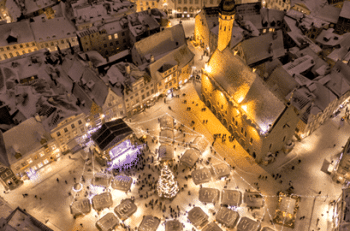As part of the Christmas celebrations, most homes across the UK will have a real or artificial tree in their home. But where does this tradition come from – here we explain the history of Christmas trees.
 Although Prince Albert is often given credit for introducing the Christmas tree to England in 1840, it was actually George III’s German wife, Queen Charlotte, who set up the first recorded tree at Queen’s Lodge in Windsor in December of 1800. The trees were adorned with fruit, flowers, and candles.
Although Prince Albert is often given credit for introducing the Christmas tree to England in 1840, it was actually George III’s German wife, Queen Charlotte, who set up the first recorded tree at Queen’s Lodge in Windsor in December of 1800. The trees were adorned with fruit, flowers, and candles.
Christmas trees then became popular with the wealthy and upper class, who would often use them for children’s gatherings.
These early Christmas trees were usually any nearby evergreen tree that could be uprooted, and they would then be candle-lit and decorated with trinkets. They would also typically be surrounded by presents.
Prince Albert went on to import spruce firs from his native Coburg, Germany, to serve as Christmas trees in December 1840.
However, it wasn’t until a few years later when periodicals such as the Illustrated London News, Cassell’s Magazine and The Graphic began describing these royal Christmas trees that the custom caught on amongst the general public in England.
This also means that Queen Victoria and Prince Albert were – probably – the first Christmas tree influencers!
—oooOooo—
Christmas Trees: A Forgotten History
Here, The History Guy gives an upbeat history of the Christmas tree which, he says, deserves to be remembered. He even highlights that the first ‘Christmas tree’ might have been put in Latvia – but not as a Christmas tree as we know it! He then points out that the first real record of a Christmas tree being decorated and used to celebrate the festivities was in Alsace (between France and Germany) in 1576.
—oooOooo—
Huge rise in Christmas tree popularity
The 1860s saw a huge rise in Christmas tree popularity among the middle class when families would set up their trees in prominent places like the parlour or hall, covering them with candles, sweets, fruit and homemade decorations.
The author Charles Dickens also underpins the rising popularity of the festivities in his work notably, A Christmas Carol in 1843.
This period is also when the tradition of leaving small gifts under the tree began as well.
Real trees were the norm for many years and artificial bristle Christmas trees were unheard of until Addis Housewares Company made the first one in 1930. Though two US-based retailers were selling artificial trees from 1883, the UK didn’t see this type of tree until the 1920s when Woolworths began selling them. Then Addis produced their trees – using the bristles it made for toilet brushes!
And since the 1930s, growing numbers of people started buying artificial trees that they could put up and decorate every year.
Growing popularity of Christmas trees in the UK
However, to reflect the ever-growing popularity of Christmas trees in the UK, Norway has gifted Great Britain a large Christmas tree to display in Trafalgar Square, London every year.
This began in 1947 and this annual tradition reflects that during the Second World War when Norway was occupied, the Norwegian king and government fled to London for safety.
They are grateful to the people of London for their assistance and have given them a Christmas tree every year as a symbol of appreciation.
This holiday custom demonstrates how essential Christmas trees are currently still considered in Britain today.
—oooOooo—
Christmas wreaths
 Another tradition at Christmas is for people to put up Christmas wreaths. But where do they come and how did this tradition start?
Another tradition at Christmas is for people to put up Christmas wreaths. But where do they come and how did this tradition start?
It is thought that ancient Romans gave each other wreaths as rewards for military successes and excellence.
They also used laurel or olive branch wreaths to crown winners of the Olympic Games.
And during Kalends — the New Year festival celebrated by the Romans — people exchanged wreaths, garlands and other small tokens with one another.
It is believed that the first Advent wreaths were used by Lutherans in Germany in the 16th century.
However, the first recorded use of this custom was in 1833, when a Lutheran clergyman lit a candle on a wreath every Sunday and told the nativity story. This custom spread to homes and churches and continues today.
In the 1800s, people hung wreaths on their front doors as a sign of welcome. These rings were usually made of holly, ivy, pinecones and ribbons.
—oooOooo—
More history about the growing popularity of Christmas trees
Outside of the UK, Christmas trees have also grown in popularity with families around the world and they have been a part of the Christmas celebration for centuries.
The first recorded use of a Christmas tree was in 1533, when German theologian Martin Luther is said to have decorated a small evergreen tree with candles to celebrate Christmas and enjoy the beauty of nature.
In the 18th century, trees were decorated with lights and the tradition quickly spread throughout Europe and by the 19th century, Christmas trees were being set up in homes and public squares in many countries around the world.
In Britain, Christmas trees were also becoming increasingly popular, and they began to appear in public spaces in the Victorian era, with the first being put up in London’s Trafalgar Square in 1841 and in 1848, a giant Christmas tree was put up in Leicester Square.
The Christmas tree has continued its popularity with most homes having one – and for many, the trees remain a symbol of hope, joy and love.
—oooOooo—
The history of the Christmas tree
This video by TodayisTomorrowsPast is an interesting explanation of why Christmas trees became such a strong tradition. While there is a lot mystery of the tree’s humble origins for being the main choice to have in every home, the video explains that the Celts had a lot to do with it. One of the earliest appearances of a Christmas tree was in a Strasbourg Cathedral in 1539.
—oooOooo—
Why do we have Christmas trees?
The ancient Egyptians are known to have brought green palm branches inside their homes during the winter solstice, a symbol of life in the middle of winter.
And during Roman times, Pagan celebrants decorated their houses with evergreens and hung-up wreaths of laurel, an evergreen with pagan associations, as a part of the Saturnalia festival honouring the god Saturn.
While the reasons for bringing evergreen trees inside during the winter months are varied — from Pagan fertility symbols to Christian icons of hope — the Christmas tree has come to represent the promise of new life in the dark days of winter.
For many, it is a reminder that even during cold and darkness, there is the potential for warmth and light.
—oooOooo—
Where does the tradition of mistletoe come from?
 The Roman author Pliny the Elder described how Druids in Gaul ceremonial harvested mistletoe from oak trees that they revered.
The Roman author Pliny the Elder described how Druids in Gaul ceremonial harvested mistletoe from oak trees that they revered.
Oak trees were also found in Britain, so in the 19th century antiquarians interpreted Pliny’s description as meaning that these ceremonies took place during Christmas time too.
However, Pliny did not mention the season or Britain.
Mistletoe brought indoors on Christmas Eve was a popular English decoration for centuries.
The first known use of mistletoe at Christmas time comes from the poet Robert Herrick’s poem Ceremonie upon Candlemas Eve:
‘Down with the Rosemary, and so, Down with the Baies, & mistletoe.’
It is also unknown if the correlation between Christmas and mistletoe was developed in the 17th century, or if there were earlier references.
According to English tradition, the act of kissing under the mistletoe was first recorded in 1784 comic-opera Two to One.
‘When at Christmas in the hall
The men and maids are hopping…
Cry, ‘What good luck has sent ye?’
And kiss beneath the mistletoe.’
—oooOooo—
The history of Christmas tree
The custom of erecting decorated evergreen trees as part of Christmas celebrations is now widespread among Christians and non-Christians around the world.
Many different cultures have developed their own unique traditions and ways of celebrating with Christmas trees and it is now an integral part of the UK’s festivities, regardless of whether the person doing so is a Christian, a non-believer or a follower of another faith.
Today, Christmas trees can be bought from local markets and supermarkets and, no matter where they come from, trees are a key part of making the festive season special – and will remain so for many years to come.





